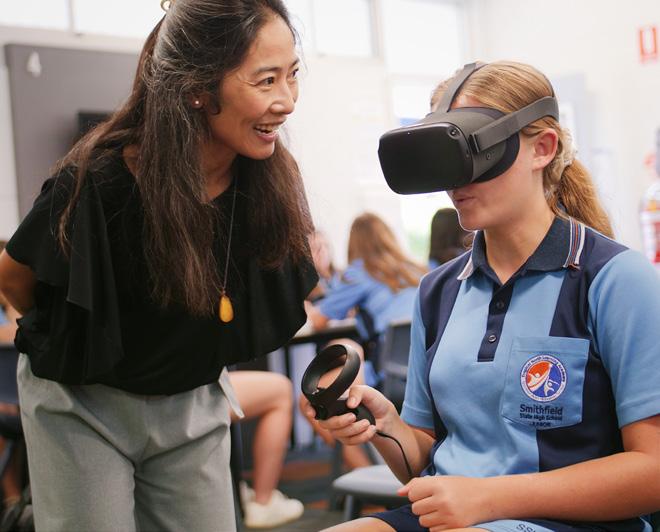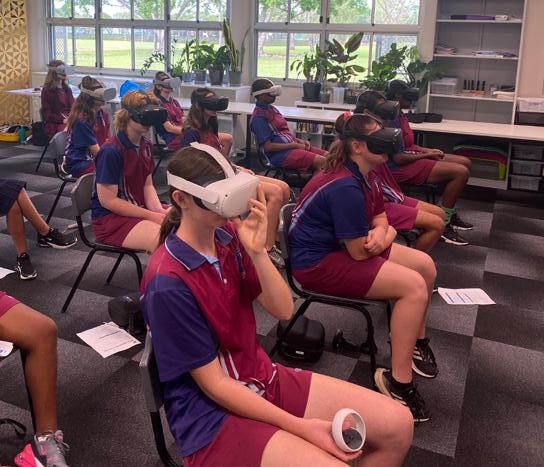
5 minute read
Research Report
ENGAGEMENT WITH REGIONAL SCHOOL STUDENTS THROUGH THE VIRTUAL CONSTRUCTION SITE TOUR - AN IMMERSIVE EXPERIENCE
- a summary of the 2019 NAWIC IWD Scholarship Research Report
by Dr Fiona Lamari
Senior Lecturer in Construction Management, Faculty of Engineering, QUT & 2020 NAWIC IWD Scholarship Winner and NAWIC Chapter Co-Vice President (QLD)
Travelling back 20 odd years ago, I told my Dad I wanted to study construction at university. Dad was taken aback. No one in my family worked in the construction-related industry. My Dad said, “Daughter, construction is not a place for girls. Climbing up and down [the scaffold].” He shook his head, in awe of my choice of further study. Dad did not stop me from putting down a construction course as my first preference, but he did insist that I put down more conventional options such as business administration and accounting as my second and third preferences. I received an offer to study a construction course in Hong Kong. The rest is now history. Fast-track 20 years, through my years working in the education sector, I get questions from students, parents and teachers - I have a student interested in a placement in construction. Is it safe? What is it like to work on site? “What is better than to show them what actually happens on a construction site?” I thought. This was the birth of the Virtual Construction Site (VCS) tour. The overarching project aim is to demystify the construction industry by promoting the exciting, diverse career options for high school students through an immersive virtual experience, the VCS tour, to take a peek at what goes on behind the gates on a construction site. The VCS tour offers an authentic experience similar to a physical construction site visit. The VCS tour takes students on a trip in a personnel hoist to the top of the jump form and finishes at the display suite. During the VCS tour, students meet with a diverse range of professions on the project and hear their career journeys in the construction industry. This project also evaluated whether the VCS tour experience has an impact on students’ perception of the construction industry and students’ consideration of a construction career. The VCS tour was offered to high schools through NAWIC Queensland’s In-School Experience Program. 76 students (16 male and 60 female) from three high schools from three different regions in Queensland participated in this research project from August to November 2019.
KEY FINDINGS
• 99% of participating students enjoyed the VCS tour experience. • The VCS tour experience has a positive impact on changing students’ perceptions of construction being a male-dominated career with a net 34% improvement overall. Particularly, these findings revealed a net favourable movement of 40% in regional students. • Four in five students believe they have an increased understanding of people’s roles in construction after the VCS tour experience. • The VCS tour experience increases students’ level of interest in construction • The VCS tour experience can trigger students’ consideration for a career in construction, an 11% increase in regional students. • School teachers could see huge potential in class teaching using immersive engagement such as the VCS tour.
To download a copy of Dr Fiona Lamari’s report visit nawic.com.au

Overall, students’ comments on the VCS tour experience were greatly positive. Students found the virtual experience very interesting and ‘cool’. Most students did not have any previous experience with virtual reality and were excited with the opportunity to see virtual reality in ‘action’. Students were interested in being on the construction site. “Whoa” and “it was so real” were comments students remarked on the moment they finished the VCS tour. Some female students also commented “there are so many women in construction” and appeared genuinely surprised.
RECOMMENDATIONS
• Virtual experience is an excellent engagement tool with high school students. • The VCS tour has the potential to be used as a medium to generate discussions and class activities using an actual construction project as the backdrop. • Opportunities to collaborate with schools to clarify career plans in construction - see the working environment and hear what people do in construction. • The VCS tour makes the site visit cost-effective, safe and accessible. Students can explore the construction site in a safe environment, more so for students from regional locations whom would otherwise be unable to attend the site visit due to cost and distance. • Immersive technology, such as virtual 360 video, can offer a powerful and insightful experience to students on ‘a day in my life’ which can demystify the working environment of the construction site and increase their awareness of the industry. • Industry and universities should take advantage of the immersive technology space and engage with students and school teachers and provide more clarity on the skills students need, and what one can expect, from a career in the construction industry. • Universities should explore opportunities with school teachers to develop teaching activities using the
VCS tour as the basis for class discussions and case studies. For example, in physics, pre-tensioned reo and material science, as well as essential project skills. • The VCS tour exposes students to diverse role models and projects in an immersive environment and has an impact on changing students’ perceptions and it develops career optimism in construction.
POSTSCRIPT
From August 2019 to June 2021, the VCS tour has been experienced by university students in Brisbane and Indonesia. The VCS tour has also made its way to high school students from 20 schools across Queensland - Cairns, Innisfail, Townsville, Brisbane, Toowoomba and Redland. Feedback from students and teachers has been greatly positive and I look forward to sharing this experience to more students in all regions.









